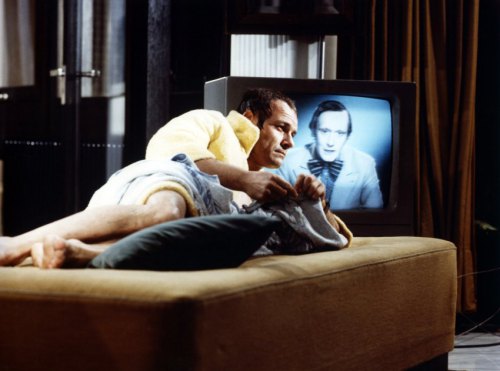
by Sam Juliano
There can be nothing more disconcerting to a young child than finding out that their latest book find is well beyond their sphere of negotiation. The exasperated yellow duckling with the pink beak in veteran artist Sergio Ruzzier’s latest innovative creation, This is Not a Picture Book is initially ecstatic when he comes upon a book with a bright red cover. Soon enough the anticipated eye candy is exposed as a tome, one indecipherable to an ankle-biter, whose sphere of enlightenment has up until now been in the most stringent visual terms. Gloriously framing this pained encounter between this impressionable tyke and the latest step in learning are the first set of end papers that reveal that words by themselves are indecipherable at the earliest stage, in fact they project to said prospective reader the futility of a foreign language. After the exclamatory titular pronouncement on the double page spread that sets off the deceit with Duck Amuck bravado our offended protagonist rejects his latest acquisition, rethinks his action, and finally atones in a series of delightful vignettes that make striking use of white space. The duckling picks up the book again and is approached by a cricket who asks “What is that?” The duckling repeats the central dilemma, and the cricket deems it “Wacky” and asks if his new friend is able to read it. Surprisingly the duckling doesn’t rule out the possibility just before the book enters a new dimension.
Ruzzier, the Italian born classicist who is unwaveringly in the Caldecott hunt for the fourth consecutive year has produced what is probably his picture book masterpiece, and by any artistic and conceptual barometer of measurement one of the finest works of 2016. Like all the best creations, This is Not A Picture Book is thought-provoking, elegant, and invested with the most vital, if rudimentary measure of advocacy for our youngest readers. The book celebrates the power of reading and the unlimited boundaries of the imagination. Once again Ruzzier’s colorful and sumptuous otherworldly tapestries evoke a European sensibility and some of his eccentric carnival scenes envision the surrealist cinema master Alejandro Jodorowsky, though framing the art as Felliniesque seems just as appropriate. (more…)






















 Click on names for archives
Writers/Founders
Click on names for archives
Writers/Founders